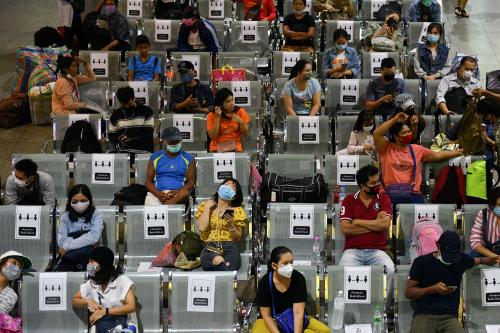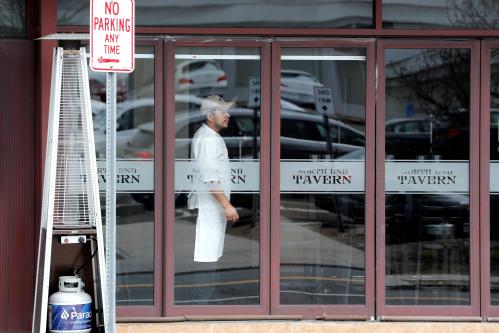There is a crisis of demand brewing around the globe as social distancing becomes the norm to counter the COVID-19 outbreak. Examples of job cuts abound as authorities ask restaurants and bars to close shop. Manufacturing activity in global value chains is increasingly disrupted too. Ripple effects will likely be felt with a negative demand shock for consumer durables such as cars, and the ability of factories to supply at capacity will be affected as lockdowns are imposed. So, which parts of the economy are most in the line of fire?
One way to assess this vulnerability is to look at jobs that can be done at home through estimating the percentage of workers employed in activities that relate to daily work outdoors or the operation of vehicles, mechanized devices, or equipment. There is a different and equally relevant dimension of face-to-face interaction with consumers that reflects the importance (normalized on a scale of 0-1) of tasks that involve (a) establishing and maintaining personal relationships; (b) assisting and caring for others; (c) performing for or working directly with the public; and (d) selling to or influencing others. Both these measures are based on 900 job titles from the Occupational Information Network (O*NET) database for the United States.
Differences across industries
Home-based work and face-to-face interactions expectedly go hand-in-hand in several industries. For example, professional, scientific, and technical services can be provided from home and require little face-to-face interaction. Conversely, accommodation and food services and retail trade are not amenable to home-based work and intensive in face-to-face interactions. The same holds true for health care and social assistance, which are at the forefront of providing essential services during the COVID-19 pandemic. But there are industries where these two measures diverge, which is why it’s important to look at both. For example, manufacturing and construction work cannot be done from home but also do not involve much face-to-face interaction with consumers. Conversely, education services are amenable to home-based work and yet intensive in face-to-interactions (Figure 1).
Lockdown and beyond
As nonessential services are increasingly suspended due to the COVID-19 outbreak, industries less amenable to home-based work are particularly vulnerable to immediate job losses. This includes accommodation and food services and retail trade where worker layoffs in restaurants (home delivery options notwithstanding) and department stores are becoming increasingly commonplace. Manufacturing may also face job losses during lockdown if the need for social distancing among factory coworkers or the closure of public transportation suspends the production of nonessential goods. The health care industry is less vulnerable to job loss, but doctors, nurses, and other health personnel face the risk of getting infected as they respond to COVID-19 related cases.
Among industries that are amenable to home-based work, it will likely be close to business as usual for those least intensive in face-to-face interactions, such as professional, scientific, and technical services. However, those intensive in face-to-face interactions are likely to experience negative productivity shocks during lockdown even if some tasks can be delivered digitally. For example, high school teachers can provide lectures through web-based applications, but the teaching quality might be lower compared to interactive sessions in the classroom. Similarly, branch managers and investment advisors in financial services can liaise with clients through online and telephone banking, but their ability to sell new products might be inhibited. Therefore, people employed in these industries are less likely to lose their jobs or face lower wages despite a productivity shock in the short run.
As lockdowns are lifted, the constraint on doing only home-based work eases. Therefore, among industries not amenable to home-based work, those with low face-to-face interactions, such as in manufacturing, will likely see workers return to their jobs more easily. Industries intensive in face-to-face interactions may be slower to recover as consumers may remain apprehensive of going to restaurants or stores.
Distributional impact
Occupations that are more amenable to home-based work are largely concentrated among higher wage deciles. This includes legal, management, and computer-related jobs. In contrast, occupations less amenable to home-based work and therefore at higher risk of layoffs are largely concentrated among lower wage deciles. This includes personal care, food services, and production jobs (Figure 2). Occupations intensive in face-to-face interactions that relate most closely to physical proximity are similarly concentrated among lower wage deciles. A large share of women’s employment is also accounted for by occupations which are intensive in these face-to-face interactions (Figure 3). This pattern of potential job losses during the COVID-19 outbreak is therefore likely to disproportionately affect vulnerable groups.
In responding to job losses owing to the COVID-19 pandemic, governments should take this heterogeneity in the feasibility of doing home-based work and face-to-face interactions into account. The temporal dimension also matters. Once restrictions are lifted, continued support to industries will likely be most needed where face-to-face interactions matter. This could help the vulnerable tide over these difficult times. It will hopefully not be too long before the tide of COVID-19 turns too.










Commentary
When face-to-face interactions become an occupational hazard: Jobs in the time of COVID-19
March 30, 2020